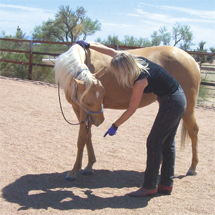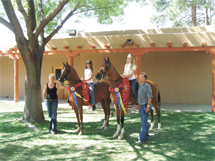The Leslie Nichols Relaxation Program
By Joanne Holmberg | August 20, 2008
Highly successful, proven techniques and exercises for both the horse and rider revealed at Sept. 14 event at WestWorld
 In her professional work with horses over the last six years, Phoenix-based progressive horsemanship instructor Leslie Nichols developed in-hand and under saddle techniques to calm horses: some traumatized; some angry; some highly nervous. Through the training of nine-month-old to 20-year-old horses of many breeds (including Quarter horses, Thoroughbreds, Friesians, Arabs, Mustangs, Paints, Appaloosas and Andalusians), Nichols learned that a Relaxation Response, a conditioned response that overrides the flight impulses, can be taught to horses and called up at will.
In her professional work with horses over the last six years, Phoenix-based progressive horsemanship instructor Leslie Nichols developed in-hand and under saddle techniques to calm horses: some traumatized; some angry; some highly nervous. Through the training of nine-month-old to 20-year-old horses of many breeds (including Quarter horses, Thoroughbreds, Friesians, Arabs, Mustangs, Paints, Appaloosas and Andalusians), Nichols learned that a Relaxation Response, a conditioned response that overrides the flight impulses, can be taught to horses and called up at will.
More...
Pet Health Education
Heartworm Disease
Heartworm disease is a serious, life threatening disease for dogs, and although less frequently, cats. It is spread by mosquitos, and any dog living in an area where there are heartworm positive dogs and mosquitoes present is at risk. When the mosquito bites a dog that has heartworm disease, it picks up blood carrying an immature parasite called microfilariae. This immature parasite then develops into the infective stage larvae in the mosquito. When the mosquito bites another dog, it transmits the larva, and infects the dog. The immature heartworm migrates throughout the tissue of the body, and eventually reaches the heart where it develops into an adult heartworm. The adult heartworm can reach a length of 6-18 inches.
Dogs with heartworm can be completely symptom free, or can show one or more signs such as coughing, listlessness, weakness, weight loss, or labored breathing. Dogs can be treated for heartworm disease; however treatment can be difficult, so prevention is the best medicine.
Pets here in the valley should be tested yearly for heartworm, and treated monthly with the preventative, Heartgard Plus Chewable Tablets. Heartgard also treats and prevents the intestinal parasites roundworms and hookworms.


